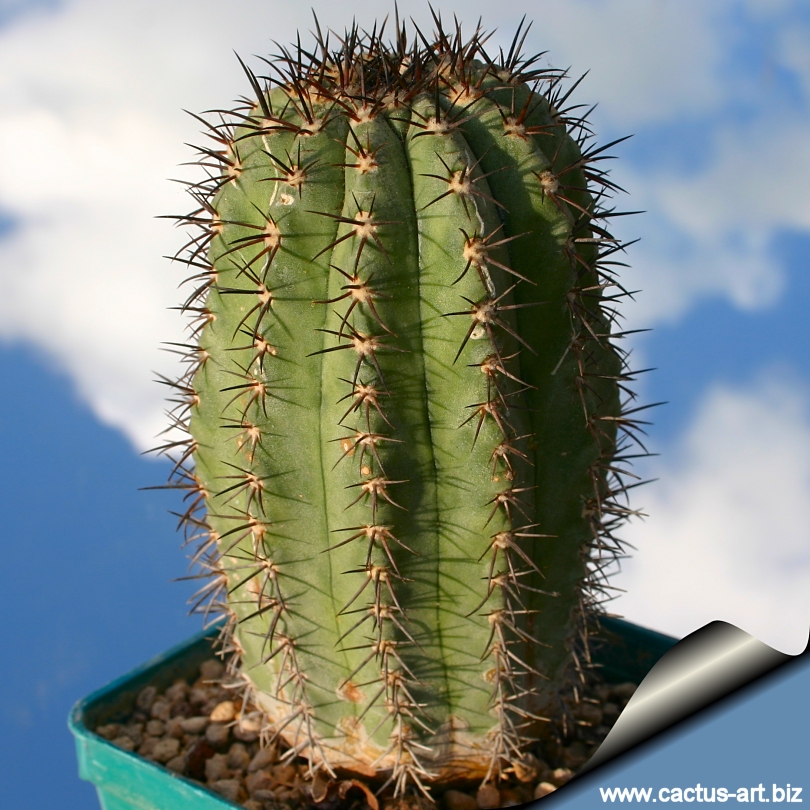|
|

Copiapoa marginata.
|
 |
Description: Plants,
solitary or growing in clusters of 2 to 9, usually erect, but
when old spreading with ascending tips.
Stem: Subcylindric or ellipsoid (narrowed towards the top and the
base), ashen-green, with domed crown, woolly at the top.
Up to 18 cm tall,
8-12 cm wide.
Ribs: 8 to 12 (usually 10), separated by broad intervals, slightly
convex, rounded off towards the top but flattened nearer the base, with
very obtuse grooves in between.
Areoles: Broad, almost round, entirely confluent (flowing
together), convex, young areoles and tops of flowering plants filled
with tufts of soft brown or black felted wool;
Radial spines: 5-7 spreading outwards, more or less standing out
in a radiating manner,
subulate, stout, rigid, straight, at first chocolate brown,
afterwards becoming greyish; The lower-most, more strongly growing, are
all stiff and straight
Central spines: Single, the longer one 3 cm. long and standing
straight out. Under the magnifying glass they are seen to be marked with
faint lines.
|
|
Flowers: Yellow, 2.5 cm. long with outer petals upright, acute-lanceolate,
pointed and of a reddish colour, inner petals upright, obtuse, with
a very
short terminal point. The crowded filaments as well as the anthers are
yellowish; the style is thick and hollow, the eleven stigma lobes
yellow.
Blooming season: Spring and summer
Fruit: Naked, small, 8 mm. long;
Seeds: Black, shining.
Note: This appears to be a variable species. |
|
Advertising
|
|
|
|
|
Family:
Cactaceae
(Cactus
Family)
Scientific name:
Copiapoa marginata (Salm-Dyck.)
BR. & R. 1922
Origin: Chile, Prov. Atacama, Coastal hills from
Antofagasta to Caldera, and is the most northerly species of this
genus.
NOTE: C. marginata, is the plant that was chosen as the
type species of the
genus when it was created by Britton & Rose. But for some 60 years,
the true identity of C. marginata was the source of contention and
discussions until Ritter designated the plants from Morro Copiapó as the
neotype.
Conservation status: Listed in
CITES appendix 2.
Synonyms:
- Echinocactus marginatus Salm-Dyck
Original Publication: Allgem. Gartenztg., 13:386
1845
- Echinocactus columnaris Pfeiffer 1847
- Echinocactus streptocaulon Hooker
In: Curtis‘s Bot, Mag, 77 (1851)
- Echinocactus melanochus Cels
in LAB. 1853
Copiapoa streptocaulon (Hooker) Ritter
In: K.u.a.S., H. 1, S. 4 1961
- Copiapoa bridgesii (Pfeifer) Backeberg sensu Ritter
- Copiapoa marginata var. bridgesii (Pfeiffer)
Hoffmann
- Copiapoa chaniaralensis
- Copiapoa atacamensis
- Copiapoa lembckei Backeberg 1959
- Copiapoa calderana F.
Ritter
- Copiapoa atacamensis
- Copiapoa calderana subsp. atacamensis.
Cultivation: Needs full sun,
otherwise the bodies tended to elongate in cultivation, but
it should be protected from excessive heat and
sun in summer. Requires light watering,
and good drainage. Keep warm and dry in winter to avoid rot.
Frost tolerance
0°C
Propagation: Seeds (offsets
rarely), Grafting is often used to speed growth rate, and to create a
back-up to plats in collection.
|
|
|
|
Photo of conspecific taxa, varieties, forms and cultivars of
Copiapoa calderana.
(This
Taxon has lots of
synonyms ( like many other Copiapoa) with several controversial
varieties and subspecies, and comprises several different forms, but
where each form is linked to others by populations of plants with
intermediate characteristics):

 |
|